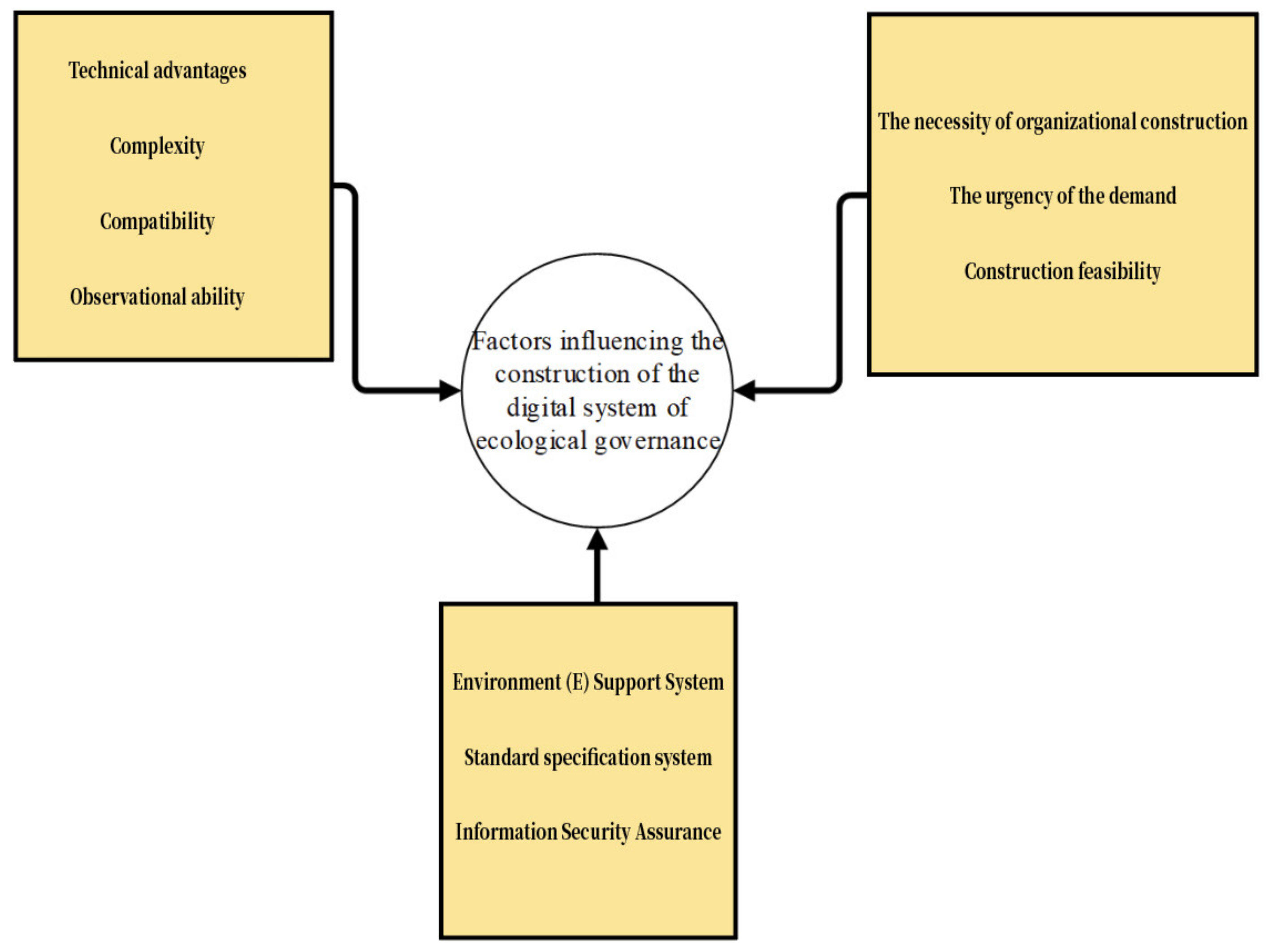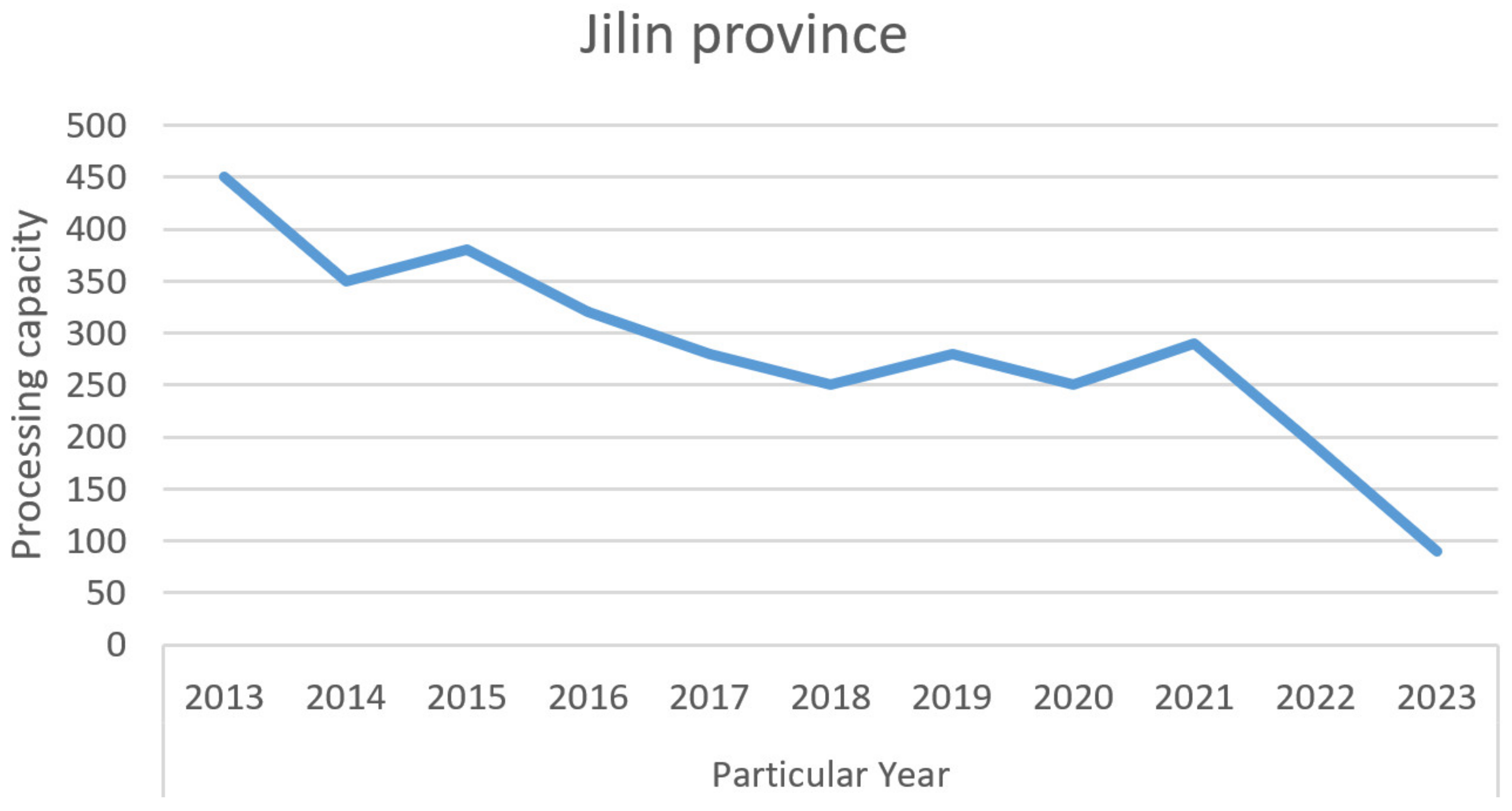Establishment and Application of Modern Ecological Governance Systems from the Perspective of Digital Empowerment
Abstract
:1. Introduction
2. The Practical Problems of the Digital Governance System of the Ecological Environment System
3. Construction of a Digital System for Ecological Environment Governance
3.1. Construction Principles
3.2. Air Pollution Digital Early Warning
4. Experimental Design and Analysis
4.1. Data Source
4.2. Data Analysis
5. Conclusions
Author Contributions
Funding
Institutional Review Board Statement
Informed Consent Statement
Data Availability Statement
Conflicts of Interest
References
- Kolomboy, F.; Palutturi, S.; Rifai, F.; Saleh, L.M.; Amiruddin, R. Leadership style based on the study of multifactor leadership questionnaire in Palu Anutapura hospital. Gac. Sanit. 2021, 35, S432–S434. [Google Scholar] [CrossRef]
- AlNuaimi, B.K.; Singh, S.K.; Ren, S.; Budhwar, P.; Vorobyev, D. Mastering digital transformation: The nexus between leadership, agility, and digital strategy. J. Bus. Res. 2022, 145, 636–648. [Google Scholar] [CrossRef]
- Wang, X.C.; Jiang, P.; Yang, L.; Van Fan, Y.; Klemeš, J.J.; Wang, Y. Extended water-energy nexus contribution to environmentally-related sustainable development goals. Renew. Sustain. Energy Rev. 2021, 150, 134–158. [Google Scholar] [CrossRef]
- Mirolyubova, T.; Voronchikhina, E. Assessment of the digital transformation impact on regional sustainable development: The case study in Russia. Int. J. Sustain. Econ. 2022, 14, 24–54. [Google Scholar] [CrossRef]
- Ren, X.; Zhao, Y.; Wu, L.; Jiang, J.; Zhang, C.; Tang, X.; Han, L.; Zhu, M.; Wang, Z. Towards efficient digital governance of city air pollution using technique of big atmospheric environmental data. IOP Conf. Ser. Earth Environ. Sci. 2020, 502, 12–31. [Google Scholar] [CrossRef]
- Fan, Y.; Long, S.; Zhang, R.; Ge, C.; Zhang, Y.; Zhang, Q. Effect Evaluation of Eco-Environmental Big Data Resource Integration and Data Sharing Construction. Wirel. Commun. Mob. Comput. 2022, 12, 245–267. [Google Scholar] [CrossRef]
- Kun, Q.; Nan, Y.X. Study on “Internet +” intelligent environmental protection to promote the modernization of environmental governance in Liaoning Province. E3S Web Conf. 2021, 261, 572–589. [Google Scholar] [CrossRef]
- Kostka, G.; Zhang, X.; Shin, K. Information, technology, and digitalization in China’s environmental governance. J. Environ. Plan. Manag. 2020, 61, 1–13. [Google Scholar] [CrossRef]
- Kruk, S.R.; Kloppenburg, S.; Toonen, H.M.; Bush, S.R. Digitalizing environmental governance for smallholder participation in food systems. Earth Syst. Gov. 2021, 23, 235–268. [Google Scholar] [CrossRef]
- Hsu, A.; Yeo, Z.Y.; Weinfurter, A. Emerging digital environmental governance in China: The case of black and smelly waters in China. J. Environ. Plan. Manag. 2020, 63, 14–31. [Google Scholar] [CrossRef]
- Figueiredo, I.; Esteves, P.; Cabrita, P. Water wise—A digital water solution for smart cities and water management entities. Procedia Comput. Sci. 2021, 181, 897–904. [Google Scholar] [CrossRef]
- Giudicianni, C.; Herrera, M.; Nardo, A.D.; Adeyeye, K.; Ramos, H.M. Overview of Energy Management and Leakage Control Systems for Smart Water Grids and Digital Water. Model. 2020, 1, 134–155. [Google Scholar] [CrossRef]
- Arlinghaus, J.C.; Rosca, E. Assessing and mitigating the risk of digital manufacturing: Development and implementation of a digital risk management method. IFAC-Pap. 2021, 54, 337–342. [Google Scholar] [CrossRef]
- Bauer, D.; Tyler Leverty, J.; Schmit, J.; Sydnor, J. Symposium on insuretech, digitalization, and big-data techniques in risk management and insurance. J. Risk Insur. 2021, 88, 525–528. [Google Scholar] [CrossRef]
- Zhu, X.; Yin, Z.; Liu, Y.; Feng, B.; Wang, Y. Study on Framework Design of Smart Water Management System in Shenzhen. IOP Conf. Ser. Earth Environ. Sci. 2019, 330, 032008. [Google Scholar] [CrossRef]
- Choi, Y.H.; Cho, W.S.; Lee, K.H. Big Data Governance Model for Smart Water Management. J. Bigdata 2019, 3, 1–10. [Google Scholar]
- Kim, J.H. Accelerating our current momentum toward smart water. Smart Water 2019, 3, 2. [Google Scholar] [CrossRef]
- Zhu, Z.; Liu, N.; Li, X.; Yuan, Z.; Wang, G. The status quo and development trend of smart water research. MATEC Web Conf. 2019, 246, 02013. [Google Scholar] [CrossRef]
- Liao, J.; Wan, A.T.; He, S.; Zou, G. Optimal model averaging for multivariate regression models. J. Multivar. Anal. 2022, 189, 252–265. [Google Scholar] [CrossRef]
- Hesamian, G.; Akbari, M.G. A robust multiple regression model based on fuzzy random variables. J. Comput. Appl. Math. 2020, 143, 270–278. [Google Scholar] [CrossRef]
- Ullah, F.; Qayyum, S.; Thaheem, M.J.; Al-Turjman, F.; Sepasgozar, S.M. Risk management in sustainable smart cities governance: A TOE framework. Technol. Forecast. Soc. Change 2021, 167, 476–487. [Google Scholar] [CrossRef]
- Kilani, Y. Inspecting the role of Software as a Service (SaaS) in public sector organizations with the extension of technology organization-environment (TOE) framework. Int. J. Bus. Inf. Syst. 2020, 1, 1. [Google Scholar]
- Wang, H.; Guo, J. New way out of efficiency-equity dilemma: Digital technology empowerment for local government environmental governance. Technol. Forecast. Soc. Change 2024, 200, 123184. [Google Scholar] [CrossRef]
- Yu, J.; Chen, S. The Use of Big Data Analysis in Digital Empowerment of Sustainable Technological Innovation Management of Ecological Enterprises. Environ. Sci. Pollut. Res. 2024, 31, 43956–43966. [Google Scholar] [CrossRef]
- Xu, X.; Dai, M. Evaluation of Local Government Digital Governance Ability and Sustainable Development: A Case Study of Hunan Province. Sustainability 2024, 16, 6084. [Google Scholar] [CrossRef]








| Test | All Areas | Class A Area | Class B Area | |||
|---|---|---|---|---|---|---|
| BP test | Prob > chi2 = 0.0000 | Heteroscedasticity | Prob > chi2 = 0.0423 | Heteroscedasticity | Prob > chi2 = 0.0000 | Heteroscedasticity |
| Wooldridgetest | Prob > F = 0.0064 | Sequence correlation | Prob > F = 0.1089 | Non-sequence correlation | Prob > F = 0.0060 | Sequence correlation |
| Pesaran’s test | Pr = 0.0000 | Cross-sectional correlation | Pr = 1.6923 | Non-cross-sectional correlation | Pr = 0.0000 | Cross-sectional correlation |
| Hausmantest | Prob > chi2 = 0.0000 | Fixed effect | Prob > chi2 = 0.2764 | Random effects | Prob > chi2 = 0.0266 | Fixed effect |
| Model | Fixed-effect FGLS | GLS of Random effects | Fixed-effect FGLS | |||
| Regression Variable | All Areas | Class A Area | Class B Area |
|---|---|---|---|
| InEKlit | −0.595 ** | −1.550 ** | −0.302 * |
| (0.262) | (0.670) | (0.181) | |
| InEKlit2 | −0.046 ** | −0.112 ** | 0.021 * |
| (0.021) | (0.047) | (0.013) | |
| GDPit | 0.001 *** | 0.001 | 0.000 |
| (0.000) | (0.000) | (0.000) | |
| GDPit2 | 0.001 *** | 0.001 | 0.000 |
| (0.000) | (0.000) | (0.000) | |
| Inlndustryit | 0.528 *** | −1.653 *** | 0.559 *** |
| (0.130) | (0.397) | (0.083) | |
| lnUrbanit | 0.373 *** | 3.501 *** | 0.569 |
| (0.115) | (0.778) | (0.545) | |
| InFDlit | 0.141 *** | −0.131 | 0.121 * |
| (0.026) | (0.140) | (0.068) |
Disclaimer/Publisher’s Note: The statements, opinions and data contained in all publications are solely those of the individual author(s) and contributor(s) and not of MDPI and/or the editor(s). MDPI and/or the editor(s) disclaim responsibility for any injury to people or property resulting from any ideas, methods, instructions or products referred to in the content. |
© 2025 by the authors. Licensee MDPI, Basel, Switzerland. This article is an open access article distributed under the terms and conditions of the Creative Commons Attribution (CC BY) license (https://creativecommons.org/licenses/by/4.0/).
Share and Cite
Zhang, T.; Zhang, K. Establishment and Application of Modern Ecological Governance Systems from the Perspective of Digital Empowerment. Sustainability 2025, 17, 1176. https://doi.org/10.3390/su17031176
Zhang T, Zhang K. Establishment and Application of Modern Ecological Governance Systems from the Perspective of Digital Empowerment. Sustainability. 2025; 17(3):1176. https://doi.org/10.3390/su17031176
Chicago/Turabian StyleZhang, Tao, and Kun Zhang. 2025. "Establishment and Application of Modern Ecological Governance Systems from the Perspective of Digital Empowerment" Sustainability 17, no. 3: 1176. https://doi.org/10.3390/su17031176
APA StyleZhang, T., & Zhang, K. (2025). Establishment and Application of Modern Ecological Governance Systems from the Perspective of Digital Empowerment. Sustainability, 17(3), 1176. https://doi.org/10.3390/su17031176






